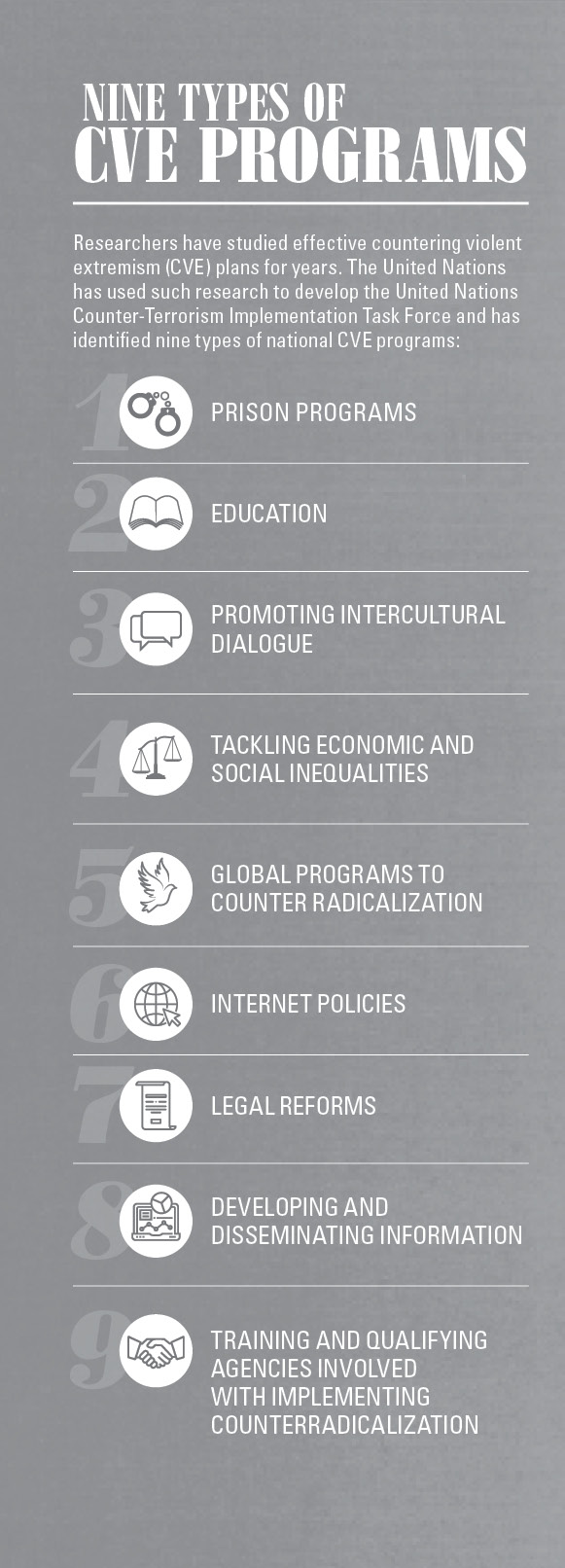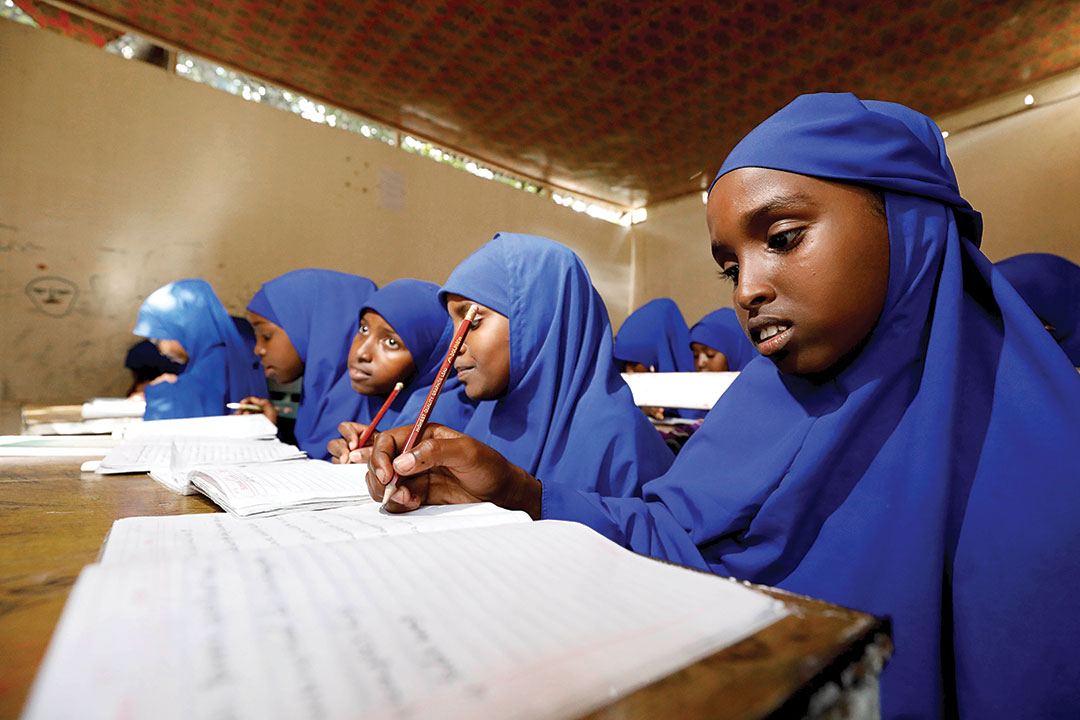Radio shows, WhatsApp groups, after-school programs and even comic books take aim at radical groups
ADF STAFF
The social media app TikTok is aimed at teenagers, who create and share 15-second videos. It has 500 million users globally, making it one of the world’s most popular apps. ISIS sees its possibilities as a propaganda tool.
In October 2019, TikTok began taking down accounts that the extremist group was using to recruit followers. The Wall Street Journal reported that the videos featured corpses being paraded down streets, along with ISIS fighters carrying guns.
TikTok, owned by the Chinese company ByteDance, said it permanently banned such accounts and is working on controls to detect suspicious activity. The ISIS videos were discovered by Storyful, a social media intelligence company. A spokesman for Storyful said “the sheer volume” of content on TikTok made it difficult for the company to police itself.
Years ago, extremists recruited followers by posting long, angry speeches and sermons by clerics on the internet — hardly attractive to young people raised on a diet of short videos. The extremists adapted and tailored their messages to suit their audience, posting material filled with violence, guns and promises of adventure. These days, extremists use the internet to spread propaganda, raise funds, recruit new members and communicate with activists.

“Today, 90 percent of terrorist activity on the Internet takes place using social networking tools,” cyber terrorism expert Evan Kohlmann told
The Washington Post. “These forums act as a virtual firewall to help safeguard the identities of those who participate, and they offer subscribers a chance to make direct contact with terrorist representatives, to ask questions, and even to contribute and help out the cyber-jihad.”
Opponents of extremism have struggled to counter such messaging. Shutting down extremists’ websites, such as Facebook pages, has not been the answer; extremists merely set up shop at another website or social media page. Long-term solutions can come only from projects and programs countering violent extremism, also known as CVE.
SOCIAL MEDIA
CVE programs use positive and negative measures. Positive measures include producing content that counters extremist messages and challenges extremist propaganda. Negative strategies can be blocking, filtering and taking down extremist content.
A 2016 study, “The role of online/social media in countering violent extremism in East Africa,” noted that a strategy for countering extremist narratives consists of three parts: the message, the messengers and the media.
The message should be multilayered, imaginative and flexible enough to be tailored to specific groups. It can link to existing narratives. Researcher William Robert Avis says that a message that appeals to emotional connections and makes careful use of humor can be successful.
The messenger must have credibility with the target audience. Government leaders, religious leaders and reformed radicals can be effective messengers, depending on the audience. Reformed radicals have been underused in this regard, because some government leaders think the radicals must be punished.
The media requires careful distribution and dissemination of the counternarrative message. In East Africa, radio is one of the most essential forms of media, but other, newer forms also are used, including social media and peer-to-peer communication apps such as WhatsApp.
These countermessages have become critical to preventing extremist conversions. Terrorist actions have become harder to predict, making traditional military and law enforcement techniques inadequate. Extremists no longer are limited to working within organized, hierarchical groups. In his 2012 report, “Lone Wolves in Cyberspace,” researcher Gabriel Weimann focused on extremists who work solo.
Lone-wolf terrorism is the fastest-growing form of terrorism, said Weimann. “The real threat now comes from the single individual, the ‘lone wolf,’ living next door, radicalized on the internet, and plotting strikes in the dark.”

PARTNERSHIPS
In a 2013 study, researchers Stephen White and Kieran McEvoy determined that a partnership approach involving law enforcement, intelligence agencies, other statutory organizations and community-based nongovernmental organizations (NGOs) “with grassroots credibility” is more likely to result in effective CVE. Other researchers have noted that NGOs should not merely be perceived as formal organizations but need to include groups and individuals at grassroots levels, such as parents, women, teachers, mentors, coaches and religious leaders.
“The principles of meaningful partnership in this domain must include mutual respect, acknowledgment of respective strengths, skills, and expertise between agencies and community-based organizations, and a willingness, in appropriate circumstances, to take calculated risks to ensure that so-called hard-to-reach groups are approached by those with the required local knowledge and technical capacity,” White and McEvoy concluded.
Experts have spent years researching what does and does not work in countering radicalization. They say results are hard to measure. For example, if nothing happens, it’s difficult to tell whether a certain action is responsible for preventing it.
A 2014 study, “Preventing and countering youth radicalization in the European Union,” said that counterterrorism concerns should not aim exclusively at Muslim communities, because they risk alienating them. A 2013 study by the International Centre for Counter-Terrorism noted that the focus of counterterrorism should be to strengthen and empower communities from which radicals and terrorists might be drawn.
 In a 2014 study, “Prevention of violent extremism in third countries,” researchers Magnus Ranstorp and Peder Hyllengren said CVE programs don’t have to be high-tech.
In a 2014 study, “Prevention of violent extremism in third countries,” researchers Magnus Ranstorp and Peder Hyllengren said CVE programs don’t have to be high-tech.
“There are several good examples and inspiring models of how civil society can counter violent Islamic extremism,” the researchers said. “This can be done through, for example, initiatives led and governed by women, strengthening youth initiatives or through innovative ways through the use of popular and local culture, and by crafting and deploying specific messages to counter the narrative of extremism.”
Women and young people are essential to CVE because they have so much at stake. Women, young people and even children have been specifically recruited and trained as suicide bombers. They have been influenced by radicals advocating hate and intolerance.
“Women and young people are not just the groups most vulnerable to extremism and violence but are also best placed to combat extremism in the community,” the researchers said.
LESSONS FROM SOMALIA
For most of the 21st century, Somalia has been a testing ground for CVE methods. Women there play a critical role in preventing extremism because of their respected position as mothers in the home. They are in an unrivaled position to observe worrisome behavior changes in their children.
Women can be important advocates to “demystify the life of a terrorist: to speak openly about the hardships of separation, insecurity, loss of income, anxiety about a covert life,” concluded the Center on Global Counterterrorism Cooperation. In contrast to the idea of Muslim women as silent victims, women should be seen as influential advocates of anti-extremist measures, the center said.

Although Somali society is traditionally male dominated, within the home women hold considerable sway. Some have voiced opposition to the violence preached by extremist groups. A pronouncement from a wife of al-Qaida leader Ayman al-Zawahiri urging women to raise their children to be jihadists and martyrs was met with resistance in Somalia. Somali women have largely rejected similar instructions from al-Shabaab.
“Somali women’s groups have been very sensitive regarding al-Shabaab’s recruitment of their children and have also been opposed to al-Qaida’s advocacy of martyrdom,” reported Ranstorp and Hyllengren.
In “Somali women and peacebuilding,” researcher Faiza Jama reported: “We call on Somali mothers to raise their children on tolerance and fraternity and to teach them Islam’s righteous path, far from extremism and violence.”
In a 2018 study, “Preventing extremism in the Horn of Africa,” the Institute for Security Studies (ISS) said that successful CVE projects have “a strong focus on promoting cooperation and participation and promoting tolerance and multi-culturalism.”
“In Somalia, where interclan conflict and marginalization have been identified as drivers of violent extremism, the emphasis is on building understanding between different religious and ethnic groups,” the institute reported.
In addition to Somalia, the institute’s research focused on CVE projects in Kenya, Tanzania and Uganda. In all four countries, poverty and a lack of jobs were identified as drivers of violent extremism. No CVE plan, the study said, will work without addressing those two issues.
“It’s hard to sustain the impact if you can’t provide people with alternatives,” the study said. “People need to feed themselves, and to work and feel productive. Livelihoods and economics are an integral part of any [CVE] project.”
The United Nations also has produced a plan to counter violent extremism. The plan includes promoting dialogue and conflict prevention; strengthening good governance, human rights and the rule of law; engaging communities; empowering youth; promoting gender equality and empowering women; improving education, training and employment; and using strategic communications, including the internet and social media.

COMIC BOOKS AND WHATSAPP GROUPS
In addition to its study of CVE programs in the Horn of Africa, the ISS has produced a similar study covering Burkina Faso, Cameroon, Chad, Mali, Niger and Nigeria. The study concluded that radio remains one of the continent’s most effective means of promoting education and exchanging ideas. The study also said that social media was growing as an effective teaching tool, along with “the use of the arts, including music, theater and visual media, such as cartoons.” The study noted in particular three success stories:
• Cameroon, the institute noted, has been particularly innovative. In one project, popular Cameroonian musicians were asked to produce music containing positive messages. In another project, comic books printed in French and Arabic told stories about three young friends and the challenges they faced. The stories explained the choices they made, and how those choices would affect the rest of their lives. Children took the comic books home with them so that their parents, regardless of whether they could read, could learn the same lessons.
• A digital project in Nigeria called for women across to the country to set up WhatsApp groups and invite 100 women to join each group. The groups serve as platforms to discuss the dangers of violent extremism and early warning signs of radicalization within families.
• In northern Nigeria, which is predominately Muslim, Michael Sodipo, a Christian, established the Peace Initiative Network to address radicalization of young people. His Peace Club involves schoolchildren and young people from different religious and ethnic backgrounds who gather after school to meet, debate and play football. The Peace Club started in 2006 with 50 members. Today is has more than 8,000 participants across four Nigerian states.
Almost all CVE studies include a warning that any CVE plan must include some component for accurately measuring improvements. The ISS said that organizations working with CVE programs have to find more effective ways to measure progress and “hold governments accountable for their obligations relating to governance, justice and development.”
Other studies have concluded that the weakest aspect of most CVE programs is in monitoring and evaluating.
The United States Institute of Peace noted that attempts to evaluate CVE programs run into two major obstacles: the impossibility of “measuring a negative,” or proving that violent activity or radicalization would have occurred had there been no CVE program; and accounting for the large number of variables and outcomes beyond a CVE intervention.

